
The Genus Fuchsia
Section Ellobium
(three species)
This small section consists of just three diploid species distributed in evergreen cloud forest and oak-pine forest from Jalisco, Mexico, to northern Panama as terrestrial, or epiphytic or sometimes tuberous, shrubs from 1,450 to 3,400 meters in elevation. (Breedlove et al. 1982) The leaves are opposite or ternate. The flowers are axillary, or held in racemes or panicles, with elongated floral tubes from 20 to 65 mm long. Its nectaries are smooth and unlobed. The sepals are erect to spreading and colored green to reddish green or pale red with olive-green or bright red petals. The stamens occur in two unequal series and have yellow pollen. The seeds number between fifty and two hundred. The section's breeding system is hermaphroditic.
This section's name derives from the Greek word, ellobion, or earring. It was first applied to Fuchsia fulgens (De Candolle 1828) when the Swedish botanist, author and colorful social philosopher, Niels Lilja (see ➤ Dictionary of the Fuchsia), established a new genus for it as Ellobium fulgens in 1841. Previously in 1840, he had moved Fuchsia fulgens into Spachia fulgens. Lilja was noted for his study of Swedish plants but it's unclear why he would move a plant so far outside his native habitat not once, but twice. Ellobium has been synonymous with Fuchsia, however, when Lilja was eventually corrected by Carrière in 1881. The name was revived for this section of the genus.
Name: Fuchsia sect. Ellobium (Lilja) Breedlove, P.E. Berry & P.H. Raven, 1982.
Typus: Fuchsia fulgens DC.
Synonyms
Basionym
Ellobium Lilja, Linnaea 15: 262. 1841.
Homotypic
Spachia Lilja, Tidning för trädgårdsskötsel och allmän wextkultur, 62. 1840 ex Linnaea. 15. 262. 1841.
Section Ellobium
(three species)
This small section consists of just three diploid species distributed in evergreen cloud forest and oak-pine forest from Jalisco, Mexico, to northern Panama as terrestrial, or epiphytic or sometimes tuberous, shrubs from 1,450 to 3,400 meters in elevation. (Breedlove et al. 1982) The leaves are opposite or ternate. The flowers are axillary, or held in racemes or panicles, with elongated floral tubes from 20 to 65 mm long. Its nectaries are smooth and unlobed. The sepals are erect to spreading and colored green to reddish green or pale red with olive-green or bright red petals. The stamens occur in two unequal series and have yellow pollen. The seeds number between fifty and two hundred. The section's breeding system is hermaphroditic.
This section's name derives from the Greek word, ellobion, or earring. It was first applied to Fuchsia fulgens (De Candolle 1828) when the Swedish botanist, author and colorful social philosopher, Niels Lilja (see ➤ Dictionary of the Fuchsia), established a new genus for it as Ellobium fulgens in 1841. Previously in 1840, he had moved Fuchsia fulgens into Spachia fulgens. Lilja was noted for his study of Swedish plants but it's unclear why he would move a plant so far outside his native habitat not once, but twice. Ellobium has been synonymous with Fuchsia, however, when Lilja was eventually corrected by Carrière in 1881. The name was revived for this section of the genus.
Name: Fuchsia sect. Ellobium (Lilja) Breedlove, P.E. Berry & P.H. Raven, 1982.
Typus: Fuchsia fulgens DC.
Synonyms
Basionym
Ellobium Lilja, Linnaea 15: 262. 1841.
Homotypic
Spachia Lilja, Tidning för trädgårdsskötsel och allmän wextkultur, 62. 1840 ex Linnaea. 15. 262. 1841.
F. decidua Standl.
Mexico. Rare in moist oak-pine and evergreen cloud forests in the Sierra Madre Occidental from Jalisco to Oaxaca [growing at elevations from 0,000 to 0,000 meters].
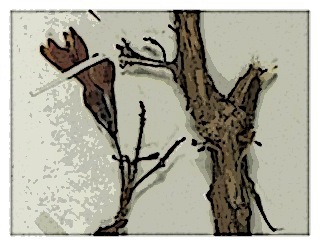
Habit—Shrub 0.5 to 2 m high, terrestrial, in rock crevices, or epiphytic in trees as high as 10 m above the ground, with fleshy tubers 2 to 4 cm thick and stoloniferous lateral shoots. Branchlets 5 to 15 cm long, 3 to 6 mm thick, subquadrangular, glabrous; older branches 0.5 to about 3 m long, 6 to 20 mm thick, with very loosely peeling, copper brown bark.
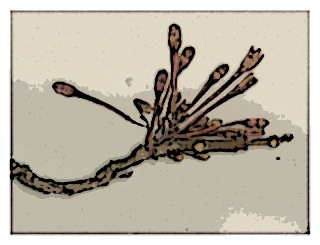
Flowers— Numerous and held in compact, lateral panicles on new shoots arising from the nodes of older stems, the rachis 2 to 6 cm long, drooping, flowering when leafless (December-May), pedicels slender, glabrous, 6 to 11 mm long, to 15 mm in fruit, peeling floral tube narrowly funnelform, 30 to 48 mm long, 1.5 to 3.5 mm wide at base, then slightly constricted above nectary and gradually widened above until 5-9 mm wide at rim, glabrous to sparsely strigose outside, glabrous within, sepals lance-oblong, 8 to 13 mm long, 3 to 6 mm wide, apex obtuse, spreading to suberect at anthesis, tube and sepals reddish pink, petals red, fleshy, oval to reniform, 1.5 to 3.5 mm long, 1.5 to 4 mm wide, erect, nectary a smooth yellow green band 3 to 5 mm high lining the base of the tube, antisepalous filaments 10 to 17 mm long, antipetalous filaments 5 to 12 mm long, anthers 1.5 to 3 mm long, 1 to 2 mm wide, style slender, 55 to 66 mm long, stigma green, slender, 1 to 1.5 mm long, ca. 1 mm thick.
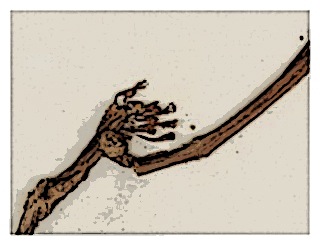
Seeds—The seeds are 1.5 to 2 mm long, 0.5 to 1.0 mm thick, and ovate in outline.
Chromosomes—Gametic chromosome number n = 11.
Authors—Standley 1929. Breedlove, Berry & Raven 1982.
Original publication—Publ. Field Mus. Nat. Hist., Bot. Ser. 4: 248 1929.
Synonyms—None.
Herbarium Specimens—California Academy; Missouri; Smithsonian.
(Illustration—Detail of flowers and branch from an herbarium specimen at the Smithsonian Institute.)
F. fulgens Moç. & Sessé ex DC.
Mexico. In oak trees or on rocks, especially around seepages and waterfalls, along the Trans-Mexican Volcanic Belt from Jalisco to the State of Mexico and in the Sierra Madre Occidental of Guerrero at elevations from 1,450 to 2,300 meters.

Habit—Soft-wooded shrubs 0.5 to 3 m tall, with thickened, tuberous underground parts, often epiphytic in trees or on rocks. Branchlets 4 to 25 cm long, 1 to 5 cm thick, semisucculent, quadrangular, subglabrous to strigose, reddish. Older branches and stems freely exfoliating, 1 to 6 cm thick.
Leaves—Opposite, soft-membranous, ovate to cordate, rounded to cordate at base, acute at apex, (5-)9 to15 cm long, (3-)5 to 12 cm wide, pale green above, lighter below and red-tinged; young leaves canescent to tomentose, the older ones short villous; secondary veins 8 to 10 on either side of the midvein, margin denticulate to serrulate with red glandular teeth; petiole stout, strigose, 3 to 8 cm long; stipules subtuberculate, lance-deltoid, 1.2 to 2 mm long, 0.2 to 0.5 mm wide, deciduous.

Fruit—The berry is elongate, 20 to 30 mm long, 8 to 15 mm thick, glabrous to sparsely strigillose and dark purple.
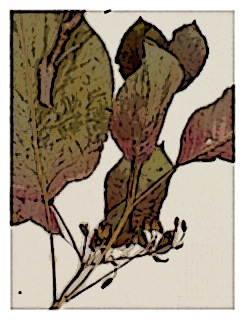
Chromosomes—Gametic chromosome number n = 11.
Authors—De Candolle 1828. Breedlove, Berry & Raven 1982.
Original publication—Prodr. 3: 39 1828.
Synonyms—Spachia fulgens, Lilja 1840; Ellobium fulgens, Lilja 1841; F. fulgens pumila, Carrière 1881; F. racemosa Sesse & Mociño 1888. Probable Garden hybrids: F. fulgens fulgens, F. fulgens var. rubra grandiflora, F. fulgens var. gesneriana, F. fulgens var. goselli, F. fulgens var. michoacan, F. fulgens var. jalisco and F. intermedia.
Herbarium Specimens—Arizona State 1, Arizona State 2, Arizona State 3, Arizona State 4; Field Museum; Paris 1, Paris 2, Paris 3, Paris 4, Paris 5.
(Illustrations—1. F. fulgens; 2. An attractively variegated garden selection of the species.)
F. splendens Zucc.
Mexico & Costa Rica. Scattered in a few moist forests in Guerrero and Oaxaca but more common in cloud forest and moist oak-pine forest from Chiapas to Costa Rica at elevations from 2,400 to 3,400 meters.
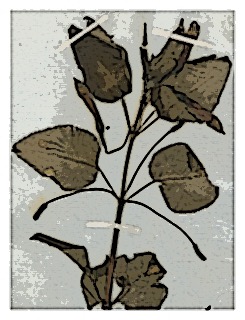
Habit—Few- to many-branched, soft-wooded shrub 0.5 to 2.5 m tall, terrestrial or occasionally epiphytic on trees. Branchlets 5 to 30 cm long, 1 to 3 mm thick, triangular to quadrangular, subglabrous to densely short-pilose or villous; older branches with smooth reddish bark, exfoliating freely with age, 0.5 to 3 m long and 8 to 40 mm thick.
Leaves—Leaves opposite or occasionally ternate, membranous, ovate to cordate, rounded to cordate at base, acute to acuminate at apex, 35 to 130 mm long, 20 to 75 mm wide, pale to dark green and subglabrous to pilose or villous above, lighter below or red tinged and similarly pubescent, especially along nerves; secondary veins 5 to 9 on either side of the midvein, margin dentate to serrate; petioles reddish, pubescent, 12 to 80 mm long; stipules lance-filiform, 1 to 2 mm long, ca. 0.3 mm wide, deciduous.
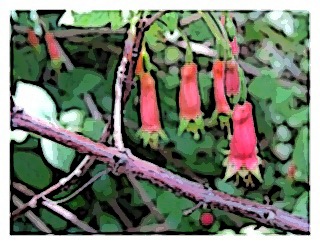
Fruit—The berry is elongate, 20 to 40 mm long, 5 to 8 mm thick, verrucose, and green to dark purple when ripe.

Chromosomes—Gametic chromosome number n = 11.
Authors—Zuccarini 1832. Breedlove, Berry & Raven 1982.
Original publication—Flora 15(2 Beibl.): 102 1832.
Synonyms—F. cordifolia, Bentham 1841; F. intermedia, Hemsley 1878.
Herbarium Specimens—Edinburgh; Kew 1, Kew 2, Kew 3.
[F. splendens var. splendens]
[F. splendens var. cordifolia]
According to Dr. Paul E. Berry, professor, director and curator at the University of Michigan's Herbarium and the world's leading scientific authority currently working on the genus, he will likely recognize two varieties as F. splendens var. splendens and splendens var. cordifolia in a future publication.